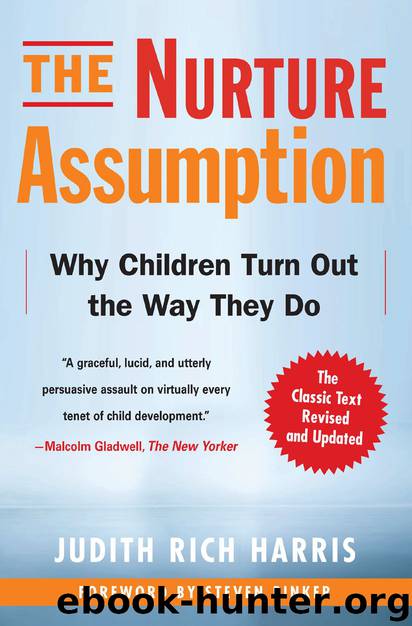The Nurture Assumption: Why Children Turn Out the Way They Do by Judith Rich Harris

Author:Judith Rich Harris [Harris, Judith Rich]
Language: eng
Format: azw3
Publisher: Free Press
Published: 2011-10-25T04:00:00+00:00
11 SCHOOLS OF CHILDREN
You probably remember how it was done. Maybe you even remember doing it yourself. The little ways that schoolchildren signal to their classmates—while still remaining within the letter of the classroom law—that they are not knuckling under to the teacher. Sociologist Sharon Carere, an ex-schoolteacher herself, has described some of the techniques children use for what she calls “playing the fine line”—defying the teacher in ways that the teacher has trouble objecting to. There is, for example, the wastebasket saunter:
Students walked to the wastebasket in a saunter. Upon arriving, each dimension of disengaging from the refuse and allowing it to fall into the holding device was executed with painstaking care and precision, and was followed by a few seconds of simply watching it lie there.
And the split-body maneuver at the bookshelves:
They positioned themselves at the structures either with book at hand, intently poring over it to assess its adequacy for their reading desires and needs of the moment, or looking over the array of books, ostensibly searching for a title that caught their interest. What was noteworthy about this institutionally defined, directed behavior was that it was specific to only part of the students’ bodies: normally the upper section appeared absorbed, while the lower half displayed social interaction and free-play concerns, including softly kicking the leg of the person next to them, using their feet to maneuver any object that might be on the floor near them, making a fist with the hand that was dangling from the arm not in use, and poking, usually gently (so as not to cause a commotion) the person next to them.
Half the fun is getting there. The trip to the wastebasket or the bookshelves can be livened up in many entertaining ways, such as “dancing up the aisles to an internal rhythm” or pretending to be a toy soldier, a tightrope walker, or a duck. For the real pro, “the action might even include a pause at the front of the room to deliver a special center-stage performance for the benefit of any fans who might be watching.”1
The fans, of course, are the other children in the classroom. The teacher is not a fan—she is one of them, the necessary foil without which the little acts of defiance would be pointless.
To children in school, the most important people in the classroom are the other children. It is their status among their peers that matters most to them—that makes the schoolday tolerable or turns it into a living hell. A large part of the teacher’s power resides in her ability to put individual children in the spotlight, to make them the focus of their peers’ attention. She can, if she is so inclined, hold up a child to public ridicule or public envy.
But a teacher can do much more than that. If, in this book, I seem to rob parents of much of their power and responsibility, I cannot be accused of perpetrating the same crime against teachers. Teachers have power and responsibility because they are in control of an entire group of children.
Download
This site does not store any files on its server. We only index and link to content provided by other sites. Please contact the content providers to delete copyright contents if any and email us, we'll remove relevant links or contents immediately.
| Administration & Medicine Economics | Allied Health Professions |
| Basic Sciences | Dentistry |
| History | Medical Informatics |
| Medicine | Nursing |
| Pharmacology | Psychology |
| Research | Veterinary Medicine |
The Art of Thinking Clearly by Rolf Dobelli(9909)
The 5 Love Languages: The Secret to Love That Lasts by Gary Chapman(9273)
Mindhunter: Inside the FBI's Elite Serial Crime Unit by John E. Douglas & Mark Olshaker(8699)
Becoming Supernatural by Dr. Joe Dispenza(7831)
The Road Less Traveled by M. Scott Peck(7275)
Nudge - Improving Decisions about Health, Wealth, and Happiness by Thaler Sunstein(7239)
Mastermind: How to Think Like Sherlock Holmes by Maria Konnikova(6936)
Enlightenment Now: The Case for Reason, Science, Humanism, and Progress by Steven Pinker(6870)
Win Bigly by Scott Adams(6826)
The Way of Zen by Alan W. Watts(6288)
Factfulness: Ten Reasons We're Wrong About the World – and Why Things Are Better Than You Think by Hans Rosling(4487)
The State of Affairs by Esther Perel(4483)
Gerald's Game by Stephen King(4372)
Man's Search for Meaning by Viktor Frankl(4267)
The Confidence Code by Katty Kay(4034)
Thinking in Bets by Annie Duke(3995)
The Worm at the Core by Sheldon Solomon(3325)
Hidden Persuasion: 33 psychological influence techniques in advertising by Marc Andrews & Matthijs van Leeuwen & Rick van Baaren(3292)
Enlightenment Now by Steven Pinker(3271)
